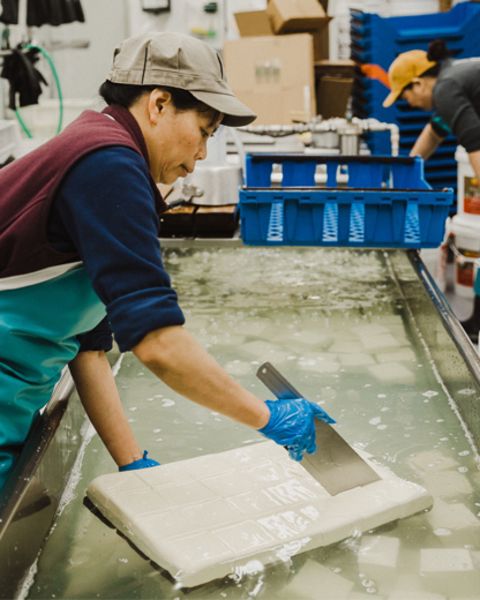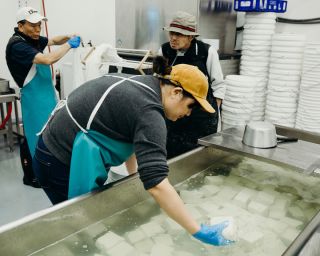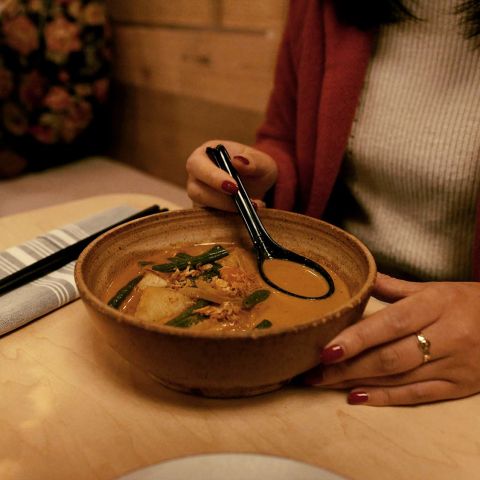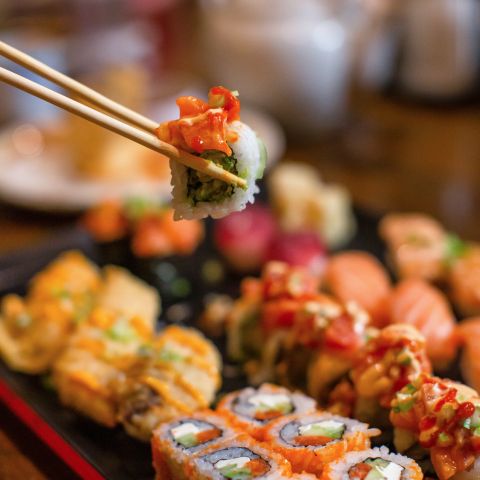
Ota Tofu: America’s Oldest Tofu House Calls Portland Home
This local family-run shop has been making tofu by hand for over a century.
Samantha Bakall
It shouldn’t come as a surprise that America’s oldest tofu house calls Portland home.
Starting in 1880, thousands of immigrants from Japan came to Oregon in hopes of finding work and a better life. Many came through Portland, and it wasn’t long before a Nihonmachi, or “Japantown,” formed in the city’s Old Town neighborhood. A growing number of young Japanese men, and eventually their wives and families, populated the area between Northwest Second and Sixth avenues. This new community created demand for hotels, restaurants, bathhouses, barbershops and other businesses owned and operated by fellow Japanese immigrants.
One of those businesses was Ota Tofu. Founded around 1911, Ota produced the familiar ivory blocks of tofu from open vats of soymilk cooked over gas-fired brick ovens.
Ota Tofu is one of the last — if not the only — Portland businesses to survive the period of Japanese internment, lasting from 1942–’46.
More than a century later, Ota Tofu is one of the last — if not the only — Portland businesses to survive the period of Japanese internment, lasting from 1942–’46. Its small, shabby building stands almost forgotten between technicolor bars, large production spaces and ever-expanding condos in inner Southeast Portland. The tofu recipe has changed little from the original incarnation, and each block is still cut and packaged by hand.
Tofu only became popular for many Americans within the last few decades, but the ingredient has been part of the bedrock of East Asian culinary traditions for millennia. For early Japanese settlers, tofu was a taste of home in an unforgiving, foreign country. Today, Ota’s hands-on production pays homage to an art lost to time and automation — though its future remains in limbo.
“I’m hoping that someone will want to do this,” says owner Eileen Ota. “It’s been really hard for me to hire somebody who wants to learn.”

The Origins of Ota Tofu
Some of the details of Ota Tofu’s origins are a mystery lost to time.
When Eileen Ota took over the company in 1987, she thought the tofu house was started in 1918. But a Portland State University project discovered advertisements for Ota Tofu from 1915. Further research found tofu being made by the original owners — two brothers named Heiji and Seizo Ohta, immigrants from Shiraishi, Okayama, Japan — as early as 1911.
The company changed hands in 1918 to Ko’s grandparents, Saizo and Shina Ohta after Heiji moved back to Japan. The pair ran the tofu house in Portland’s bustling Nihonmachi until World War II, when both were interned at the Minidoka Relocation Center in Idaho.
Mentioned Elsewhere Online
Japanese American Museum of Oregon & the Architectural Heritage Center
Saizo died at Minidoka, but upon returning to Portland, Shina discovered their sympathetic landlord had saved their equipment and shop space. She reopened the tofu house on her own.
During the war, Saizo and Shina’s daughter Matsuno (Ko’s mother) had been living and going to school in Japan. In 1955, Matsuno, her husband and children moved back to the United States in the pursuit of a more prosperous future (where their last name was changed to “Ota” due to a misspelling on their U.S. birth certificates).
After Shina had a stroke in 1957, Ota Tofu was left to her son-in-law and grandson, Ko. In 1981, they built a new location across the river that’s twice the location of the original. It still stands there today, most of it’s traditional wooden equipment traded for stainless steel.

Japanese Eats
Explore Japanese cuisine in Portland.
Portland Ramen Restaurants
The Portland ramen scene has exploded in recent years, spurred by the arrival of two authentic eateries straight from Tokyo.
Eight Great Sushi Spots Around Portland
Portland is only an hour away from the Pacific Ocean, so it should come as no surprise that the city’s sushi options are both delicious and expansive.
Portland’s Best Dumplings
From Polish pierogi to Japanese gyoza, nothing says comfort food like these doughy pockets of goodness — no matter when you visit Portland, enjoy a variety of dumplings at these terrific eateries.
How Ota Tofu is Made
Every block of Ota tofu is made by hand. Though relatively quick (Eileen estimates it takes about an hour from start to finish), the process is still labor-intensive.
Production starts the night before, when great plastic buckets — big enough to bathe a large child in — are filled with mustard yellow soybeans and water and left to soak overnight. By 4:30 the next morning, the beans are rinsed and ground with water in a small hopper to produce a milky slurry. That slurry is then pressure-cooked and strained through mesh, leaving thick, raw soymilk behind.
Similar to cheese, tofu is made from pressed curds.
Similar to cheese, tofu is made from pressed curds. Traditionally, nigari (the dried liquid rich in magnesium chloride leftover once salt is removed from seawater) was used as a coagulant. Today, Ota Tofu uses a magnesium chloride powder sourced from Japan.
Once the coagulant is added, the fresh soymilk is left to rest as the curds separate from the whey. The curds are then ladled into large stainless steel trays lined with cheesecloth where they’ll be pressed until they reach the desired firmness.
Each finished tray of tofu is then dropped into an icy cooling tank, where the entire slab is hand-cut into 24 individual blocks and chilled before packaging.
On any given week, Ota Tofu processes roughly three tons of soybeans. Those beans turn out silky, soft tofu, with a texture like perfect panna cotta. There are also medium and firm versions; a thin-pressed tofu, slowly deep-fried in rice bran oil until golden (abura-age); and a creamy, pasteurized soymilk available by the quart or half-gallon.
The Future of Ota Tofu
In the age of automation and convenience, fewer and fewer of the younger generation are interested in doing such manual work, Eileen says. And while she continues to run the business, it’s not difficult to see why she’s looking ahead. Her predominantly Chinese staff is older. Ko even works on the production floor with a portable oxygen concentrator on his back. But above all, more than 100 years of knowledge and legacy stands to be left behind.
“It’s important to keep technique — the way we’re making tofu,” Eileen said. “But if people don’t care about what they eat, then it doesn’t matter anymore… The way that we make tofu is going to go away unless somebody does it.”
Was this page helpful?


